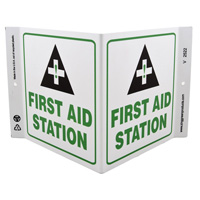



Find all of your laboratory and workplace safety supplies at Safety Emporium!
 Distance Units |
 Glossary Index |
 DOL |
| MSDS Topics |
Free Sites | FAQ's | Regulations | Glossary | Software | Suppliers |
| Books | Forum | Poll | Fun stuff | Quiz | Store | |
| Understand your MSDS with the MS-Demystifier | Search ALL our MSDS info | |||||
Diuretics cause or increase urine production or urine flow out of the body. Diuretics also decrease extracellular fluid volume. Diuretics regulate urine production by stimulating or inhibiting the body's natural hormones.
Diuresis is increased production of urine by the kidney.

We have all kinds of safety wall signs at Safety Emporium.
Diuretics are used in medicine to treat heart failure, liver cirrhosis, hypertension, and some kidney diseases. Urine contains electrolytes (such as sodium and potassium cations) and metabolic wastes in a watery (aqueous) solution. As the body excretes (expels) more urine, more electrolytes and water diffuse into the blood to replace that lost during urination.
Proper electrolyte balance is essential to good health, and diuretics may cause electrolyte imbalance. The most common electrolyte imbalance, hyponatremia, having too little sodium, can result from the use of diuretics. Hypernatremia, too much sodium, can also be caused by diuretics. Sodium imbalances should be corrected gradually because drastic changes in sodium level can cause brain cell shrinkage and damage to the pons region of the brain.
Diuretics may also cause hypokalemia, abnormally low potassium level. Patients taking diuretics are sometimes given potassium supplements to prevent hypokalemia, but one should only take these on advice of a physician. Special "potassium-sparing" diuretics are available for those on long-term diuretic therapy.
Electrolyte imbalance can be treated with one or more of the following:
Diuretics such as ephedra (ma-huang) are sometimes used as a part of weight loss programs. Care should be taken when taking diuretics to avoid dehydration (excessive body water loss) and electrolyte imbalance. See the NIH link on this topic under Further Reading below
Common household diuretics include coffee, alcohol, and cranberry juice.
Diuretics can appear in Section 11 (toxicological information) of a Safety Data Sheet as a symptom of exposure as well as Section 4 (first-aid measures).
Some chemicals are diuretics; if ingested, they can cause increased urine production or urine flow. Thiazides and loop diuretics are two common classes of diuretics used in medical treatment.
Diuretics may be used to treat ingestion of small quantities of harmful chemicals, such as thallium and cholecalciferol-based rodenticides.

Help your workers beat dehydration with heat stress prevention signs from Safety Emporium.
See also: antidote, concentration, nephrotoxin.
Additional definitions from Google and OneLook.
Entry last updated: Sunday, July 10, 2022. This page is copyright 2000-2025 by ILPI. Unauthorized duplication or posting on other web sites is expressly prohibited. Send suggestions, comments, and new entry desires (include the URL if applicable) to us by email.
Disclaimer: The information contained herein is believed to be true and accurate, however ILPI makes no guarantees concerning the veracity of any statement. Use of any information on this page is at the reader's own risk. ILPI strongly encourages the reader to consult the appropriate local, state and federal agencies concerning the matters discussed herein.